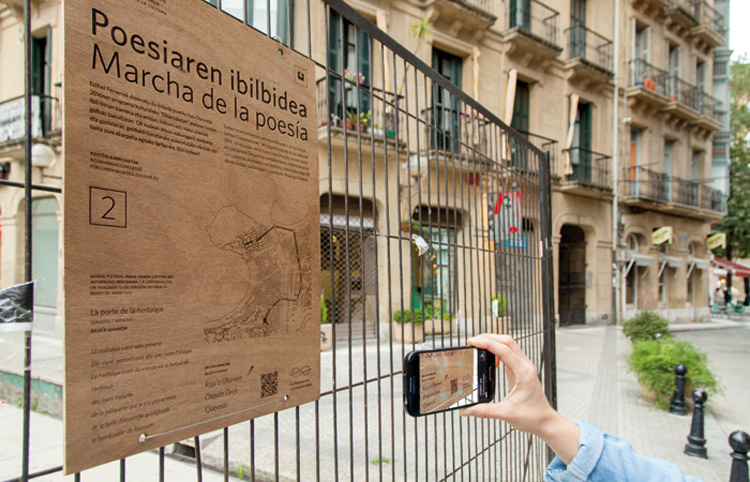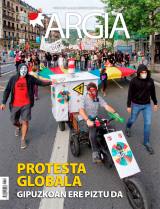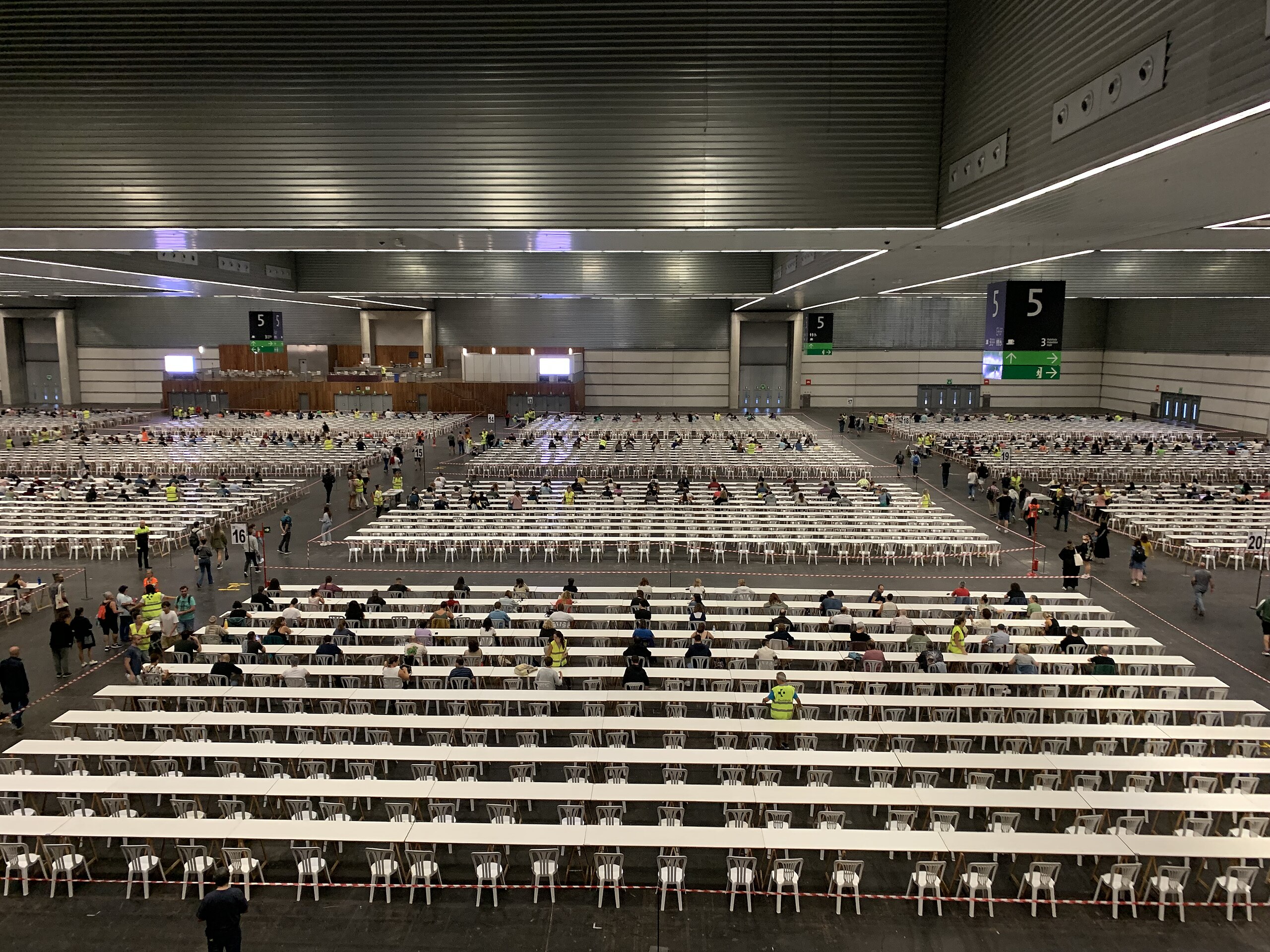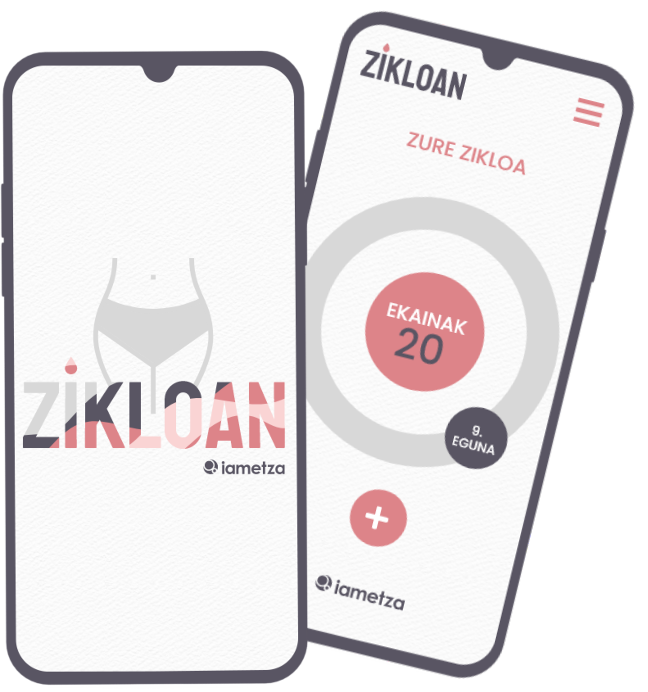
Proposal by the Donostian artist Esther Ferrer: a poetic tour of San Sebastian. San Sebastian 2016 commissioned him to do the Poetry Route. It is a street exhibition with panels in 12 points, such as the kiosk of Easo Square, the Plaza de la Constitución, the watch of the Zurriola, Tabakalera and the Koldo Mitxelena Kulturunea. Suppose we're at the kiosk of Easo Square. Inside the panel is the QR code. We'll take the phone out of the pocket and scan the code through the QR reader. The web tells us: Elisabeth Khaxas, Enheduanna and Itxaro Borda are the invited poets of this corner and we will be able to read their respective poems in Basque and Spanish. In addition to reading, you can hear these poems. This is one of the results of the Multilingual Guides platform developed by the Elhuyar Language and Technology unit.
We will give another example. The Okendo House of Culture of Donostia-San Sebastian has hosted until a couple of weeks ago the exhibition El Bien Robado. San Sebastián 2016 created the contents of the exhibition in Basque and Spanish, but using the platform Multilingual Guides, that is, using its own mobile, the same information that could be obtained in English and French. The translators and professional speakers were in charge of molding the original texts and voices. Through machine translation and voice synthesis, the contents and audios were created in Japanese, Chinese, Italian and German.
How many languages do you want to translate?
Itziar Cortes, from Elhuyar, has given us the explanations about this platform they have developed, and considers it an interesting project for museums, exhibitions or other projects related to tourism. The tourist movement is getting bigger and bigger and finding ways to communicate with everyone is not so easy. How do we manage languages if the people who come to the museum are from a dozen linguistic communities?
The Multilingual Guides platform uses several Elhuyar language technologies, the most basic are machine translation and voice synthesis. Whoever has prepared the contents, say, who has prepared the exhibition for a museum, will decide in which language he wants to give the information in physical form, such as the description in the panel, and in what language he will be available on the Internet. It will be he who decides whether the automatic translator wants to translate it into German, Japanese, Chinese or if he prefers a professional translator to do so. Let us remember that, in general, automatic translators have not yet reached an excellent level of translation and that the work of the editor is necessary to leave the translation orderly. Another thing is that it is done through machine translation and the user realizes it. So you will know that you will not read a beautiful translation but that it will serve you to receive basic information. With a similar voice. Text-to-speech conversion can be done automatically, but the client can request that the voice be recorded by professionals. Itziar Cortes considers that this platform is very suitable to keep the multilingual content on the web up-to-date, and considers it important to correct with the size of the texts: The size of the content captured with the QR code should be suitable for reading and listening from the mobile; for example, if the text is too long, it will be harder to read on the screen of the mobile device and listen to audio, it can be uncomfortable.
The system is also valid for visually impaired people. Some of you can't read the panel, but you can scan the QR code with your phone. Thus, the museum or the organization of the exhibition will be able to listen to the audio on the website that it has prepared. The challenge is to find a way to reach a solution for the blind at all.
Itziar Cortes believes that the multilingual platform is appropriate for museums and exhibitions. In addition to the hunger to learn tourists, they simply have hunger and often struggle to understand meals. We asked if you considered the QR system appropriate for the menus: "For each dish you can't put a QR next to it, but making a list of all the dish options, why not use this system? It can be."
Gida Eleaniztunak sisteman, itzulpen automatikoak egiteko gaztelaniazko bertsioa hartzen dute oinarri. Euskarara itzultzeko Matxin itzultzaile automatikoa erabiltzen dute; ingelesera, galegora eta katalanera itzultzeko Opentrad zerbitzua; eta gainerako hizkuntzetarako Google Translate moduko itzultzaile automatiko sistemak. Testua automatikoki ahots bihurtzeko Elhuyarrek bere ahots sintesi zerbitzua erabiltzen du euskara, gaztelania, ingeles, galego eta katalanerako. Beste hizkuntzetarako voiceRSS eta Googleren ahots sintesi zerbitzuak darabiltza.
Niri asteazkenean iritsi zait mezua, whatsapp bidez: “Lagundu iezadazu munduari itzulia ematen. Nico naiz” (ikusi irudia). Ziztu bizian zabaldu da astearte goizean Madrilgo ikastetxe batean abiaturiko esperimentua: helburua, ohartzea irudiak zeinen azkar hedatzen... [+]
Android gailuetan euskararen presentzia gorabeheratsua da eta teklatuaren kalitatea aldakorra da. Ondorioz jende askorentzat telefonoan euskaraz idaztea beste hizkuntza batzuetan idaztea baino deserosoagoa da. Bestalde teklatu hauetako askok pribatutasun aldetik zalantzak... [+]
Harreman berriak egiteko Tinder aplikazioan elkar ezagutu duten bi gazte dira iragarkiko protagonistak. Mutilak etengabe kargu hartzen dio neskari, badakiela neskak Tinder erabiltzen jarraitzen duela eta “atsegin dut” ematen diela beste mutil batzuen profilei.






















